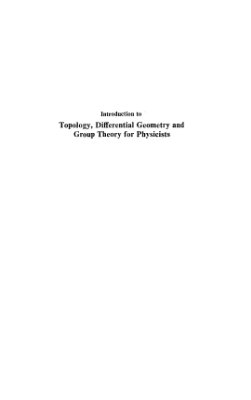Wiley Easte Limited, 1990, 223 p. This monograph is one of a
series devoted to topics in theoretical high energy physics,
originating from courses given at the Schools in this subject being
supported on a continuing basis by the Science and Engineering
Research Council of the Department of Science and Technology,
Govement of India.
The present monograph contains material from two courses covering mathematical topics which have been and continue to be of great importance and use in high energy physics-topology, differential geometry, Lie groups and algebras. Both sets of notes are reasonably self-contained, in the sense that they provide a good orientation in these subjects to the reader, but a modest degree of maturity on the part of the reader is assumed.
The material of Mukhi's notes, aimed at students with no previous exposure to any sort of "advanced mathematics", covers the basics of topology, homotopy, differentiable manifold theory, homology, cohomology and fibre bundles. Each concept is developed from scratch, and definitions and notations are made clear via examples and reasonably precise statements. The hope has been to clear the "mental block" that many young physicists seem to have towards these areas of mathematics. The relevance to actual problems in physics has been treated as secondary as compared to understanding the fundamental mathematical structures for their own sake. It is expected that in their uses in quantum field theory and general relativity the former aspect will automatically be taken care of.
The notes by Mukunda on Lie groups, Lie algebras and their representations are again meant to be an introduction to the subject, with the main focus being on the Classical Compact Simple Lie groups and Algebras. Their aim is to provide a mature reader with an orientation and a preparation to go much further on his or her own. To some extent, we have been guided by the words of Rudolf Peierls: ". . . any attempt at completeness would defeat the object of the lectures, .. , which is to illustrate, and to entertain. . ". Apart from initial sections on basic group theory, representation theory, Lie groups and algebras, some idea of the problem of classification of all Lie algebras is given. The semisimple case, and then in particular the compact situation, is dealt with in more detail. The method of Dynkin diagrams, the complete listing of all the compact simple Lie algebras, general representation theory, and finally spinor representations for both orthogonal and pseudo orthogonal groups are discussed.
The present monograph contains material from two courses covering mathematical topics which have been and continue to be of great importance and use in high energy physics-topology, differential geometry, Lie groups and algebras. Both sets of notes are reasonably self-contained, in the sense that they provide a good orientation in these subjects to the reader, but a modest degree of maturity on the part of the reader is assumed.
The material of Mukhi's notes, aimed at students with no previous exposure to any sort of "advanced mathematics", covers the basics of topology, homotopy, differentiable manifold theory, homology, cohomology and fibre bundles. Each concept is developed from scratch, and definitions and notations are made clear via examples and reasonably precise statements. The hope has been to clear the "mental block" that many young physicists seem to have towards these areas of mathematics. The relevance to actual problems in physics has been treated as secondary as compared to understanding the fundamental mathematical structures for their own sake. It is expected that in their uses in quantum field theory and general relativity the former aspect will automatically be taken care of.
The notes by Mukunda on Lie groups, Lie algebras and their representations are again meant to be an introduction to the subject, with the main focus being on the Classical Compact Simple Lie groups and Algebras. Their aim is to provide a mature reader with an orientation and a preparation to go much further on his or her own. To some extent, we have been guided by the words of Rudolf Peierls: ". . . any attempt at completeness would defeat the object of the lectures, .. , which is to illustrate, and to entertain. . ". Apart from initial sections on basic group theory, representation theory, Lie groups and algebras, some idea of the problem of classification of all Lie algebras is given. The semisimple case, and then in particular the compact situation, is dealt with in more detail. The method of Dynkin diagrams, the complete listing of all the compact simple Lie algebras, general representation theory, and finally spinor representations for both orthogonal and pseudo orthogonal groups are discussed.

